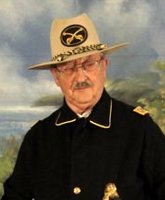Visiting Brown's Park, Heart of the Outlaw Trail
By Richard Duree (Col. Richard Dodge, SASS 1750 Life)
CLICK AN IMAGE TO ENLARGE
If you've followed my stories on the Wild Bunch in the Single Action Shooting Society Chronicle, you may recall mention of Brown's Park, way up in the northeast corner of Utah along the Green River. This is where Herb and Elizabeth Basset brought their little family in 1879, established their ranch (which Elizabeth managed) and raised their family of one son and two daughters. Those two daughters were Josie and Ann Basset (later called "Queen of the Rustlers"), beautiful and accomplished young ladies, who became very friendly with various young cowboys who came to their ranch on occasion.
Brown's Park, renamed from Brown's Hole by Elizabeth Basset, is a 35 mile-long valley enclosed by steep cliffs and hillsides along its length, blessed with plenty of water by the Green River, and good grazing for cattle. Its little community of independent ranchers was a close-knit group of hardy individuals who took a dim view of intrusion by officers of the law who might venture in seeking some of those visiting cowboys. It was a safe haven for the likes of Robert Leroy Parker, Harry Longebaugh, Ben Kilpatrick, Elzy Lay and a host of others who formed the core of a loosely organized gang of happy outlaws we now refer to as "The Wild Bunch."
By 1890, telegraph communications had spread throughout the country; lawmen could send word far ahead of fleeing outlaws to well-organized law enforcement officers almost everywhere – except into the wild country along the Utah-Colorado border. This is still rough and dangerous country with almost as much vertical real estate as horizontal, scarce water, and inhospitable weather. Brown's Park was indeed an oasis along the outlaw trail.
Blackjack Annie and I took a little road trip to the Black Hills in South Dakota and took a side trip to Brown's Park on the way back to warm Southern California where the Single Action Shooting Society was born. We could only wonder at the difficulty of traveling through that country on horseback or wagon. Even today it takes time and care to get there, but it's a wonderful drive and well worth the time.
From Rock Springs, Wyoming on I-80, about 50 miles east of the town of Green River, take Route 191 south toward Vernal, Utah. You will be taveling along the eastern rim of the Green River Canyon with spectacular canyon views. Continue to the tiny settlement of Dutch John and find the turn off to Brown's Park Road on the left. From there, it’s about 10 miles on a road occasionally paved – and occasionally not – to the crest of a ridge with a breath-taking view of the valley – Brown's Park.
Below you, the Green River winds its way leisurely through a broad-bottomed valley, aspen trees lining its banks, the land rising gently on either side, gray-green with sage and grass to the base of near-vertical walls. When we were there, the aspen trees were in various stages of green, orange and gold against the river's glittering waters. No wonder Elizabeth Basset demanded the name change.
An intimidating 16 degree grade on a fine paved road brings you to the valley floor (where the pavement ends) and you are introduced to the view upward that reveals how isolated the place is. A turn to the right when the road dead-ends takes you to the John Jarvie Ranch Historical Site. Jarvie was one of the first to settle in the valley, building a trading post and a ferry across the river. Many of his original ranch buildings still stand and are open to visitors. Park rangers are in residence (except Sunday and Monday). The water wheel still operates, built by Jarvie to supply the house and livestock with water. The original store house still stands and the reconstructed store welcomes visitors as a Visitor's Center.
A sad sign marks the spot where Jarvie was shot in the back as he fled from two "transients" who had tried to rob his store. They dragged his body to the nearby river, dumped it into a small boat, and set it adrift. The boat and body were discovered several weeks later 25 miles downstream. The murderers were never identified or captured in one of Utah's more notable unsolved murders.
There are several campgrounds on both sides of the river and a sturdy bridge for access. A drive along the river's north side reveals a kaleidoscope of changing landscape with numerous places to access the river. Boat ramps provide places to launch small fishing boats and canoes, but there are probably severe restrictions on what kind are allowed. Several canoes and floating devices were seen on the water.
The east-bound road abruptly meets the Colorado line – and pavement! The valley continues on into the distance, inviting exploration and time we did not have. The Basset ranch house was somewhere down that road, still in use. In truth, if one was not aware of the history of the place, it would be nothing more than a lovely spot to camp out in splendid isolation for a few days, but for those of us who know, Brown's Park echoes with the history of our Wild West.
